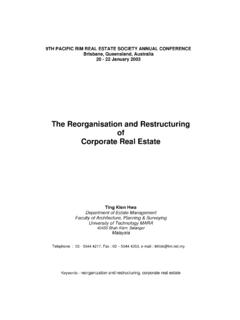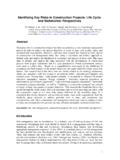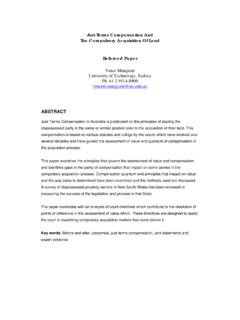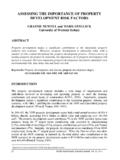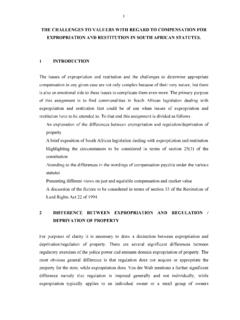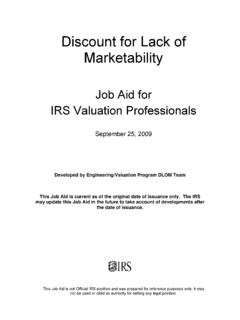Transcription of THE VALUATION OF WAYLEAVES: TIME FOR …
1 THE VALUATION OF WAYLEAVES: TIME FOR CHANGE? Norman E Hutchison* and Professor Jeremy Rowan-Robinson# *Department of Land Economy University of Aberdeen St Mary s, Old Aberdeen Tel:(01224) 273486 e-mail: (Corresponding author) #Department of Law University of Aberdeen Taylor Building, Old Aberdeen Tel: (01224) 272423 e-mail: Pacific Rim Real Estate Society 6th Annual Conference, Sydney, January 2000 The authors are grateful to Ms Fiona Leverick and Mr Thomas Munjoma for their assistance in undertaking this research and to the RICS Education Trust for its financial support. They are also grateful to Mr Andrew Pym and Dr Barry Denyer- 1 Green for their comments on a draft of this paper and to all those who provided information on current practice. 2 The VALUATION of Wayleaves: Time for Change?
2 Introduction From time to time privately held land is required for public purposes. It has for long been accepted that private rights should give way on occasion to the wider public interest. In theory, the loss to the individual is offset by the gain to the wider community of which the individual is a part. To avoid public purposes being delayed or frustrated and to ensure that private rights give way when required, Parliament has been ready to confer powers of compulsion. Public authorities such as central and local government, new town and urban development corporations and a host of others have all been able to rely on powers of compulsory purchase, including the creation of new rights falling short of ownership, to ensure that public purposes are achieved. This paper focuses on an important but relatively neglected area where privately held land is commonly required for public This is for the provision of physical infrastructure.
3 In order to bring services such as water, sewerage, electricity, gas and telecommunications to the consumer, a network of pipes and cables together with supporting facilities has to be provided. Ready access to such services is generally considered to be in the public interest and Parliament has conferred statutory powers on the suppliers, including where necessary the use of compulsion, to secure provision. These powers typically provide for the creation of a wayleave or, where a more formal arrangement is required, something akin to an easement or, in Scotland, a servitude. In recent years, the supply of these services has increasingly been passed to the private sector and the providers are commonly referred to as the utilities . This area is important, partly because of the very extensive network of pipes and cables in existence at the present time, partly because of the very large number of wayleaves that are negotiated each year (below), and partly because of the anticipated growth in the level of services to be supplied by cable and telephone during the next decade.
4 The history of the development of compulsory powers by public authorities has been one of striving to achieve a fair balance between, on the one hand, retaining adequate safeguards for the individual whose land is required and, on the other, the importance of not delaying schemes which are to serve a much needed public purpose. The former is reflected in the requirement to give notice of an intention to exercise compulsory powers, the right to object and to be heard in support of an objection and an entitlement to compensation reflecting a financial equivalent of the loss. The latter is reflected in the use of codified procedures, the delegation by Parliament of decisions on the exercise of compulsory powers in each case to a Minister and provision for fast track vesting of title.
5 In evaluating the powers conferred on the utilities, we will apply the same balance. The powers will be assessed having regard, on the one hand, to the extent to which they offer the utilities a simple and speedy means of securing access to private land where this is required and, on the other hand, the existence of adequate safeguards for the interests of the landowner. Reference to the landowner should be understood to include reference to occupiers and managers of the land where this is consistent with the text. 1 For a helpful discussion of this whole area see HW Wilkinson, Pipes, Mains, Cables and Sewers (FT Law and Tax, 6th Edn., 1995). 3 What is different about the use of compulsion by the utilities is that the supply of many of the services is now undertaken, as we have already indicated, not by public authorities, but by the private sector.
6 The privatisation programme of the 1980s transferred the supply of many of the utilities from state control to companies carrying on their business in pursuit of profit. There is nothing very new about this. In the 19th Century many of the utilities were in the private sector and operated with the benefit of compulsory powers. However, when they were brought into the public sector, procedures were streamlined and compensation was pegged to the fair market value. This owed much to the two reports of the Scott Committee which criticised the indefensible complexities of the procedures and the extravagant compensation settlements where access to private land was required for public When the utilities were eventually returned to the private sector during the 1980s, they took with them the compulsory powers accompanied, for the most part, by the streamlined procedures and fair market value compensation.
7 There was no significant adjustment in procedure or compensation to reflect their new status. A key question addressed in this paper is how far it is appropriate to apply to these bodies powers and procedures similar to those developed for public authorities exercising public functions. As McAuslan and McEldowney observe:3 ..the whole law of compulsory acquisition and compensation is based on the assumption that a public agency is acquiring land in the public interest and it is permissible in the circumstances that a legal framework is created which ensures that an even hand is held between the interests of the tax-payer and the private land-owner. It must be open to question whether the same basic framework is wholly appropriate where a commercial organisation wishes to purchase land for its commercial purposes.
8 To answer the question, we undertook a desk study to determine the nature and extent of the statutory powers providing for the creation of wayleaves and easements . The results are set out in Appendix 1. We doubt whether the list in the Appendix is exhaustive; the most we claim for it is that it is reasonably comprehensive. We also undertook an interview survey of a sample of what we regard as the key utilities to obtain an understanding of the way in which they operate in practice. By key utilities we mean gas, electricity, telecommunications, water and sewerage. We are grateful to all those who took part in the survey; the list of those interviewed is set out in Appendix 2. In addition, we contacted the bodies representing owners and occupiers of land to find out the consequences for those most affected.
9 This paper sets out our findings. Although the desk study revealed a surprisingly wide range of such powers conferred on both public authorities and the private sector, we have focused for the most part in this paper only on the key utilities. The issues raised during the research can all be illustrated by reference to these services. 2 First Report of the Committee on the Acquisition and VALUATION of Land for Public Purposes, (HMSO, 1918); Second Report of the Committee Dealing with the Law and Practice relating to the Acquisition and VALUATION of Land for Public Purposes, (HMSO 1918). 3 Electricity Act 1989, Current Law Statutes Annotated, , annotations by P McAuslan and J McEldowney. See too B Denyer-Green, Specific Purposes, Specific Powers: The Powers of Privatised Utilities in Proceedings of the National Symposium on Compulsory Purchase: An Appropriate Power for the 21st Century?
10 , DETR, 1999. 4 The central question referred to above is considered in this paper under four headings: powers procedures compensation VALUATION . These headings are now examined in turn. Powers We have drawn together the issues arising from the allocation of compulsory powers to utilities in the form of four questions. These are: (a) How far is the acquisition of wayleaves important to the discharge by the utilities of their functions? (b) To what extent do the utilities rely on compulsion as opposed to negotiation in securing wayleaves? (c) In so far as compulsory powers are required, which utilities should they be conferred upon? (d) Where compulsory powers are required, what form should they take? In this section of the paper, we attempt to answer these questions. The need for wayleaves This was one of the matters explored during the interview survey.
